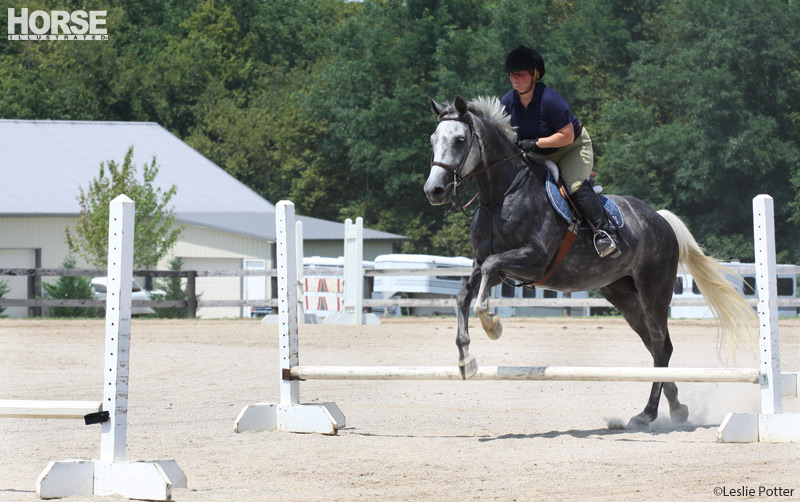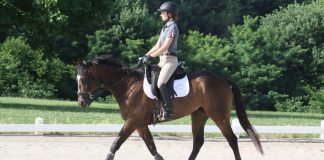
Although jumping comes naturally to most horses, to a great extent, correct jumping style must be learned. Even if you have an older horse that is more set in his ways, grids are an efficient way to improve his form over fences. Here, Gina Miles, the 2008 Olympic individual silver medalist in eventing, provides some tips on how to use grids to correct specific problems.
First-Timers
“Place two jumps 30 feet apart and plan to trot in,” says Miles. “This will give you two canter strides between the jumps plus take off and landing. Once your horse is easily handling that exercise, you can add a third jump 33 feet (two strides) from the second one.” This will get your horse comfortable with the concept of jumping through a grid before adding any other challenges.
If your horse is comfortable with the two-stride exercise, Miles recommends trying a more difficult one-stride grid. “Make the distance 18 feet between the first two jumps, and 21 feet between jumps two and three [to account for the longer canter stride as you progress through the grid]. As your horse gains more experience, you can canter into the grid, but inexperienced horses and riders should plan to trot in.”
A trot-in grid uses shorter distances early on, but with three or more jumps, you can alter the distances based on a 12-foot canter stride with 6-foot take offs and landings (24 feet for a one-stride, 36 feet for a two-stride, et cetera). “Distances are probably the most critical part of getting grids right,” says Miles. “You may need a ground person, a measuring tape and a good book with some numbers you can use. Jimmy Wofford’s book, “Gymnastics,” is a great guide, and there are other books on training horses for jumping that can give you a starting point.”
A Rushing Horse
If you’re using grids to correct an existing problem, the approach is a bit different. “For horses that rush, I use rails on the take off and landing,” says Miles. She recommends placing a take off rail 9 to 10 feet before the first jump, in the middle of the first and second jumps, in the middle of the second and third jumps, and again 10 to 11 feet after the last jump.
Another exercise Miles uses to correct horses that rush is to set up grids using extra-large cross-rails. These can also be used for horses that need to develop a better bascule or straightness over their fences. “You can raise the sides of the cross-rail and the actual jump will not be that big, but it will make the jump look bigger,” says Miles. “This gives the rusher something to look at, encourages the wiggly horse to stay straight, and gives a flat jumper a rounder bascule in the air.”
Style Makeover
Another grid Miles recommends to help horses improve their jumping style and power if they tend to be flat and careless is to set three low, wide oxers. “Keep the distances a little shorter to encourage your horse to get to the base of the oxers and jump up and round over them,” she advises.
An example exercise would be trotting in to a cross-rail set 18 feet (one stride) from the first oxer, then 20 feet (one stride) to the second oxer and 21 feet (one stride) to the third oxer. “If the oxers are really wide, you may want to use a rail placed diagonally across the top so your horse understands he is supposed to jump the whole thing, [as opposed to touching down like a bounce between the rails of the oxer],” says Miles.
For a horse that hangs his legs and needs to snap them up more, Miles recommends using distances a bit on the long side to give him time to lift his front end. “Also, use ground rails on both the take off and landing sides of the jump, rolling them out gradually [after each trip through the grid] so they end up being about as far from the jump as it is high. For example, if you are jumping a 2-foot vertical, roll the ground rails 2 feet from the front side and 2 feet from the back side.”
Straighten Out
Straightness issues can also be improved using grids. Miles recommends using guide rails along the sides of the grid. “If your horse drifts to the left when jumping, add a rail about 4 feet to the left of the center of where he will take his stride between the jumps,” she advises. Since most horses will avoid stepping on a pole, it will teach him to hold a straight course without you having to struggle with steering while thinking about the jumps.
Grids have the advantage of sorting out a horse’s jumping problems with less work from the rider. Just be sure to bring a measuring tape and a set of eyes on the ground, and your horse’s form will improve before you know it.
Click here to view diagrams of Gina’s grid exercises.
This article originally appeared in the July 2011 issue of Horse Illustrated. Click here to subscribe!






cool